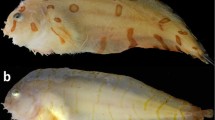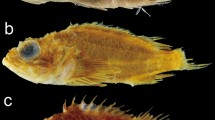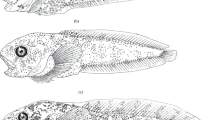Abstract
Three hundred and fifty-eight specimens of pharaoh cuttlefish, Sepia pharaonis, Ehrenberg, 1831 were collected from 30 localities in Thai waters, Gulf of Thailand (Pacific Ocean) and the Andaman Sea (Indian Ocean). Specimens were grouped according to sex, habitats and four categorised types of colour patterns on the dorsal mantle based on the number of stripes on the middle and lateral parts. Morphometry of 70 characters from five character sets of external, cuttlebone, digestive system, reproductive system and hectocotylus morphology were compared. The male and female cuttlefish were significantly different in 38 characters. Four types of males and females were significantly different in 29 and 19 characters. Overall, differences in colour patterns were more prominent in males than in females. Phylogenetic analyses of seven high-weighted characters revealed four likely clades of populations, corresponding to four types of colour patterns on the dorsal mantle.








Similar content being viewed by others
References
Anderson FE, Valinassab T, Ho C-W, Mohamed KS, Asokan PK, Rao GS, Nootmorn P, Chotiyaputta C, Dunning M, Lu C-C (2007) Phylogeography of the pharaoh cuttle Sepia pharaonis based on partial mitochondrial 16S sequence data. Rev Fish Biol Fish 17:345–352
Anderson FE, Engelke R, Jarrett K, Valinassab T, Mohamed KS, Asokan PK, Zacharia PU, Nootmorn P, Chotiyaputta C, Dunning M (2011) Phylogeny of the Sepia pharaonis species complex (Cephalopoda: Sepiida) based on analyses of mitochondrial and nuclear DNA sequence data. J Molluscan Stud 77:65–75
Bonnaud L, Lu CC, Boucher-Rodoni R (2006) Morphological character evolution and molecular trees in sepiids (Mollusca: Cephalopoda): is the cuttlebone a robust phylogenetic marker? Biol J Linn Soc 89:139–150
Chotiyaputta C (1982) Biological study on cuttlefish, Sepia pharaonis Ehrenberg, 1831. Technical paper no. 4/1982, Invertebr Sect, Mar Fish Div, Dept Fish
Dallwitz MJ, Paine TA, Zurcher EJ (1993) User’s guide to the DELTA system: a general system for processing taxonomic descriptions, 4th edition. Home page at: http://delta-intkey.com. Accessed 14 Jan 2016
Dunning MC, Norman MD, Reid LA (1998) Introduction and general remarks. In: Carpenter KE, Niem VH (eds) The living marine resources of the Western Central Pacific. Volume 2. Cephalopods, crustaceans, holothurians and sharks. FAO species identification guide for fishery purposes. FAO, Rome, pp 688–707
Jereb P, Roper CFE, Vecchione M (2005) Introduction. In: Jereb P, Roper CFE (eds) Cephalopods of the world. An annotated and illustrated catalogue of species known to date. Volume 1. Chambered nautiluses and sepioids (Nautilidae, Sepiidae, Sepiolidae, Sepiadariidae, Idiosepiidae and Spirulidae). FAO species catalogue for fishery purposes no.4, vol. 1. FAO, Rome, pp 1–19
Khromov DN, Lu CC, Guerra A, Dong ZH, Boletzky SV (1998) A synopsis of Sepiidae outside Australian waters (Cephalopoda: Sepioidea). Smithson Contrib Zool 586:77–157
Košťák M, Jagt JWM, Speijer RP, Stassen P, Steurbaut E (2013) New Paleocene sepiid coleoids (Cephalopoda) from Egypt: evolutionary significance and origin of the sepiid ‘rostrum’. PLoS One 8(11), e81180
Lu CC (1998) Use of the sepion in the taxonomy of Sepiidae (Cephalopoda: Sepioidea) with an emphasis on the Australian fauna. Smithson Contrib Zool 586:207–214
Mangold KM, Young RE (1998) The systematic value of the digestive organs. Smithson Contrib Zool 586:21–30
Nabhitabhata J, Nilaphat P (1999) Life cycle of cultured pharaoh cuttlefish, Sepia pharaonis Ehrenberg, 1831. Phuket Mar Biol Cent Spec Publ 19(1):25–40
Nesis KN (1987) Cephalopods of the world: squids, cuttlefishes, octopuses, and allies. T.F.H. Publications, Neptune City
Norman MD (2000) Cephalopods: a world guide. ConchBooks, Hackenheim
Reid LA (1998) Sepiidae. In: Carpenter KE, Niem VH (eds) The living marine resources of the Western Central Pacific. Volume 2. Cephalopods, crustaceans, holothurians and sharks. FAO species identification guide for fishery purposes. FAO, Rome, pp 723–763
Reid A, Jereb P, Roper CFE (2005) Cuttlefishes. In: Jereb P, Roper CFE (eds) Cephalopods of the world. An annotated and illustrated catalogue of species known to date. Volume 1. Chambered nautiluses and sepioids (Nautilidae, Sepiidae, Sepiolidae, Sepiadariidae, Idiosepiidae and Spirulidae). FAO species catalogue for fishery purposes no.4, vol.1. FAO, Rome, pp 106–108
Roper CFE, Voss GL (1983) Guidelines for taxonomic description of cephalopod species. Mem Natl Mus Victoria 44:49–65
Swofford DL (2002) PAUP Version 4. Sinauer Associates, Sunderland, MA. http://paup.sc.fsu.edu/downl.html. Accessed 14 Jan 2016
Tehranifard A, Dastan K (2011) General morphological characteristics of the Sepia pharaonis (Cephalopoda) from Persian gulf, Bushehr region. In: 2011 International Conference on Biomedical Engineering and Technology IPCBEE vol. 11. IACSIT Press, Singapore, pp 120–126
Tuanapaya S, Nabhitabhata J (2014) Allopatric variation of pharaoh cuttlefish Sepia pharaonis Ehrenberg, 1831, species complex in two oceans around Thai Peninsular based on mitochondrial DNA sequences. In: Ninth International Symposium of Cephalopods—Present and Past, in combination with the 5th International Symposium Coleoid Cephalopods through Time, Abstracts and program, p 142
Tuanapaya S, Nabhitabhata J (2016) Comparative external morphometry of the pharaoh cuttlefish, Sepia pharaonis Ehrenberg, 1831 from the Gulf of Thailand and the Andaman Sea, of peninsular Thailand. Phuket Mar Biol Cent Res Bull 73:15–26
Acknowledgements
The authors would like to thank the staff of the Excellence Centre for Biodiversity of Peninsular Thailand, Department of Biology, and Princess Maha Chakri Sirindhorn Natural History Museum, Faculty of Science, Prince of Songkla University for their assistance in the laboratory work. This work was also supported by the Higher Education Research Promotion and National Research University Project of Thailand, Office of the Higher Education Commission, Ministry of Education. We also express our thanks to Jorgen Hylleberg, Anuwat Nateewathana and Natinee Sukramongkol for their substantial suggestions on our manuscript.
Publisher’s Note
Springer Nature remains neutral with regard to jurisdictional claims in published maps and institutional affiliations.
Author information
Authors and Affiliations
Corresponding author
Additional information
Communicated by Y. Sakurai
Appendix
Appendix
Rights and permissions
About this article
Cite this article
Tuanapaya, S., Nabhitabhata, J. Morphometry and morphological phylogeny of Sepia pharaonis Ehrenberg, 1831 complex in Thai waters. Mar Biodiv 47, 763–775 (2017). https://doi.org/10.1007/s12526-017-0682-7
Received:
Revised:
Accepted:
Published:
Issue Date:
DOI: https://doi.org/10.1007/s12526-017-0682-7




